 Sasha Archibald
Sasha Archibald
From Modernist grid to subversive textiles, over one hundred works relay an intertwined narrative of painting and pattern, community and identity.
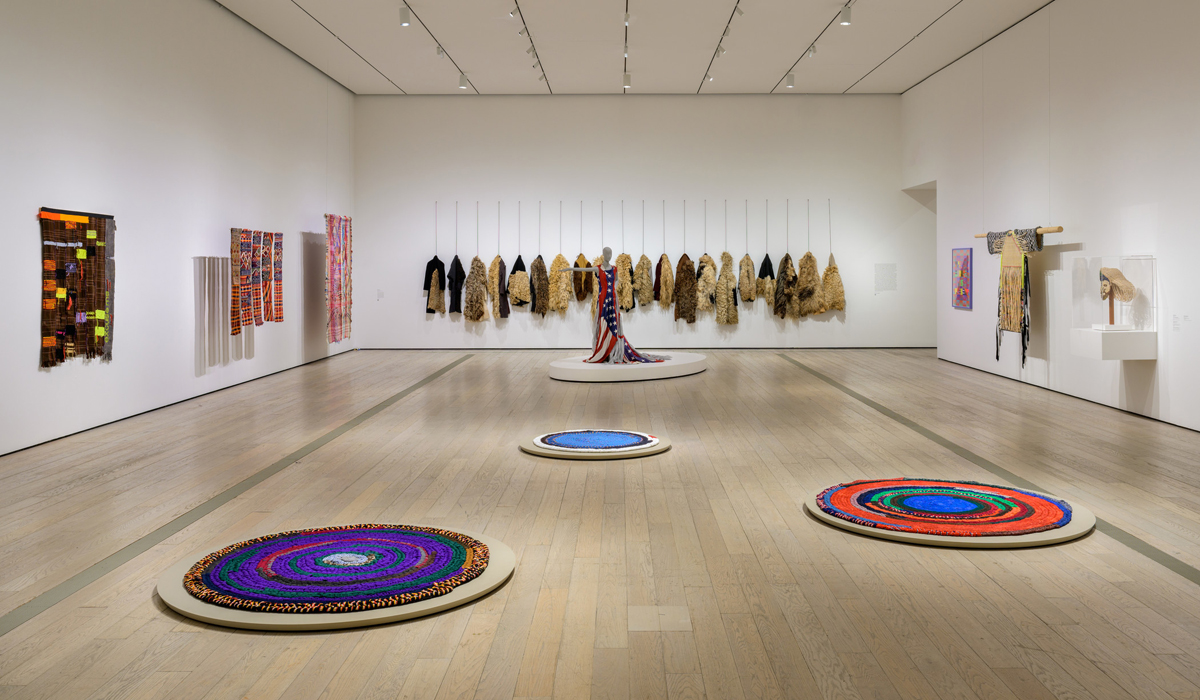
Woven Histories: Textiles and Modern Abstraction, installation view. © Museum Associates / LACMA.
Woven Histories: Textiles and Modern Abstraction, curated by Lynne Cooke, Los Angeles County Museum of Art, 5905 Wilshire Boulevard, Los Angeles, through January 21, 2024, then traveling to the National Gallery of Art, Washington, DC; the National Gallery of Canada, Ottawa; and the Museum of Modern Art, New York City
• • •
In one of the introductory galleries of Woven Histories: Textiles and Modern Abstraction, a sculpture by Sheila Hicks is installed beside a sculpture by Eva Hesse. Hicks’s is a nubbly square of beige wool that gives way at the bottom edge to thick yarn braids, dangling like a collection of lopped-off ponytails. Hesse’s sculpture is more austere: a length of thin cord extends from both ends of a half-moon curve of papier-mâché, itself snugly wrapped in black elastic; the piece hangs bluntly from a nail, looking as if it would prefer the floor. Both pieces were made in 1966, and the artists knew each other. Hicks and Hesse had earned degrees from Yale in 1959, studying under Joseph Albers, in a program with very few women.
It’s obvious from the juxtaposition that the two shared interests—in droop and cluster, in chaos tacitly controlled, in low-pitched absurdity. And yet, as curator Lynne Cooke explained in a gallery talk, pairing Hicks and Hesse was for many decades unthinkable: such was the fire wall separating art and craft. Hicks did craft, Hesse did art, and never the twain shall meet. In fact, according to Cooke, Hesse’s stalwart supporter Lucy Lippard fretted when she began using cord, precisely because the material was too craft-adjacent. One piece of string might unravel Hesse’s ambitions.
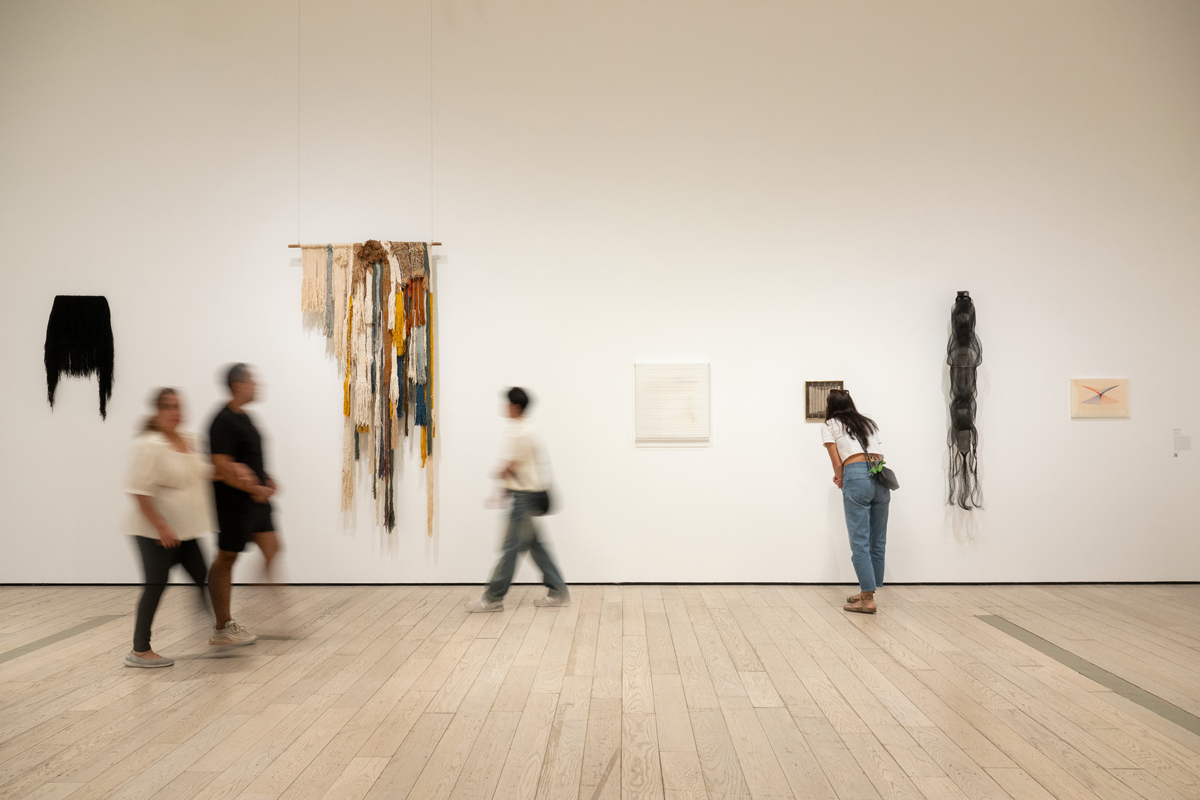
Woven Histories: Textiles and Modern Abstraction, installation view. © Museum Associates / LACMA.
Such genre rigidity feels antiquated nowadays, but it was once the atmospheric reality. Back when, certain things didn’t need to be said: art attends to the mind and textiles to the body. Baskets are not art, and neither is needlework. The apex of Modernism is a painted grid, and a painted grid has no relationship whatsoever to the grids that comprise all woven fabric. (Sure, they look alike, but ignore that.)
With over 150 artworks ranging from 1913 to 2023, Woven Histories articulates a subversive strand within Modernism’s trajectory. The exhibition begins with members of the avant-garde who helped formulate the movement but cheerfully steered clear the burgeoning dogmatism; once things rigidified, artists inclined to resist did so by making themselves a persistent thorn in the side.
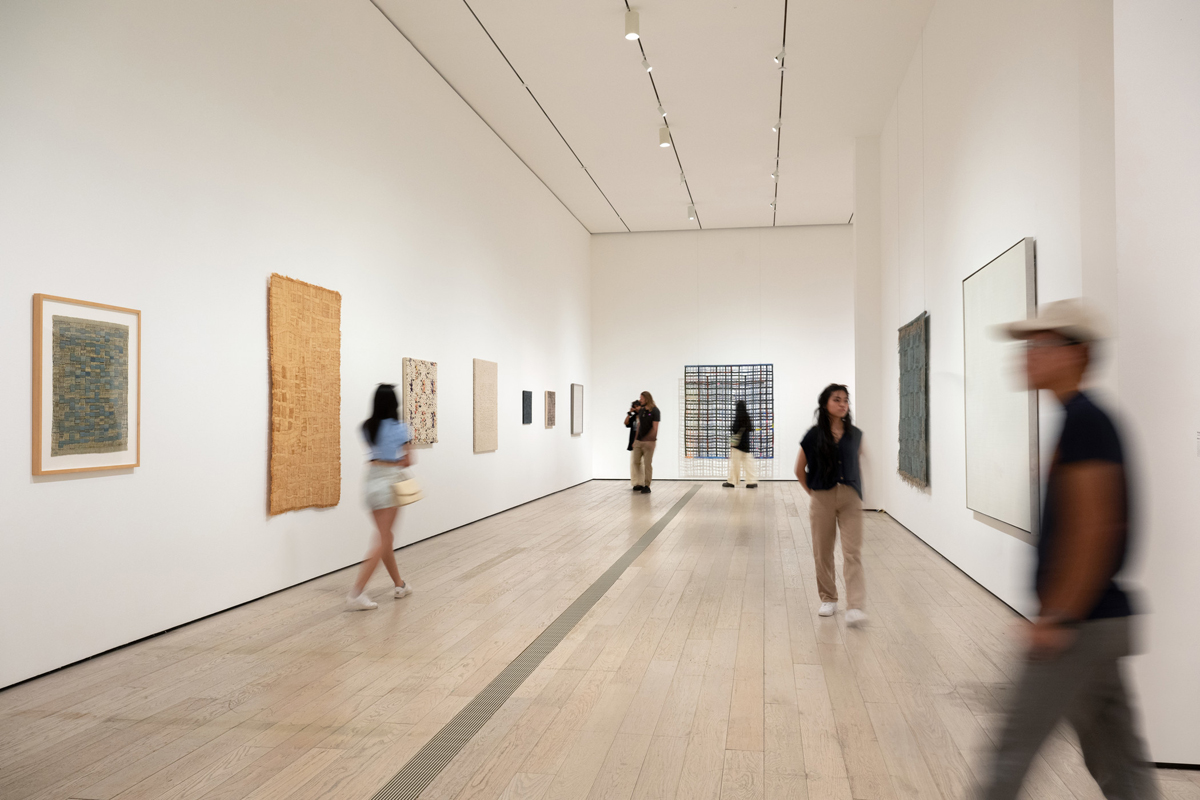
Woven Histories: Textiles and Modern Abstraction, installation view. © Museum Associates / LACMA.
It took a veritable encyclopedia of aesthetic strategy to dethrone the almighty grid. Sonia Delaunay foisted on circles to vibrating effect—her 1913 painting Electric Prisms is the earliest work in the exhibition—and designed a dress with a gridded pattern but a bubble shape. Her friend Hannah Höch spliced, stacked, and added flowers. Lenore Tawney’s Vespers and Kay Sekimachi’s Nagare 1, from 1961 and 1967 respectively, share a ghostly sag—the grid deflated, sensitive—which Alan Shield follows, a decade later, with Shape-Up, a woven lattice that seems to be infected with grid-eating termites. Olga De Amaral’s buttery tapestry of woven horsehair and a disjointed dancing sculpture by Gego, both made in 1971, are installed on either side of Agnes Martin’s 1964 Summer, such that the painting’s exquisite grid-ness appears almost a liability.
On the painting-weaving hierarchy, artists made a tag-team attack. Some hung and framed textiles precisely like paintings, as in “I dare you to find a difference.” Others made paintings of woven fabric as orderly as any Modernist grid. Harmony Hammond doubles up the transgressions; two of her “Weave Paintings” from 1974, coarse and claggy, thumb a nose at artsy formality of all kinds—I thought of place mats stained with toddler meals.

Woven Histories: Textiles and Modern Abstraction, installation view. © Museum Associates / LACMA.
Art discourse often speaks of “the line” as singular, autonomous, and proud, but most lines are inclined toward conviviality, preferring to double back rather than press on, looping and knotting and weaving, until, eventually, they become enclosures. (“Life is probably round,” said Van Gogh.) It feels natural when the grids of Woven Histories give way to baskets. I was smitten with Dorothy Gill Barnes’s Pine Bark Pair (1998), woven of stripped bark to which the tree branch is still attached, so that a bough ends in an eddy of its own making, magically replete. Nagakura Ken’ichi’s bevy of bamboo strips in the shape of an ornery neck pillow from 2001 makes no overtures, and Lillian Elliott’s haphazard bundle of broken cane and rattan, Mummy Bundle (1986), is pure improvisation. Function is beside the point—these are baskets for poetry and metaphor—but materials matter: rags, hog casings, metallic gift-wrap ribbon, text from the Indian Removal Act of 1830. What does “holding” look like?
Woven Histories shrewdly traces a path from avant-garde textile design, to entanglements between weaving and painting, to the basket revival, to textiles as global industry, and, finally, to woven objects that express identity. The exhibition narrative is broad and specific in the right proportions, with a welcome touch of whimsy, and yet I gravitated more toward a shimmery side plot, about the ways that artists find community in other artists’ work. The expanded time frame of Woven Histories makes it possible to see how a stitch dropped by one artist is picked up by another, decades later.
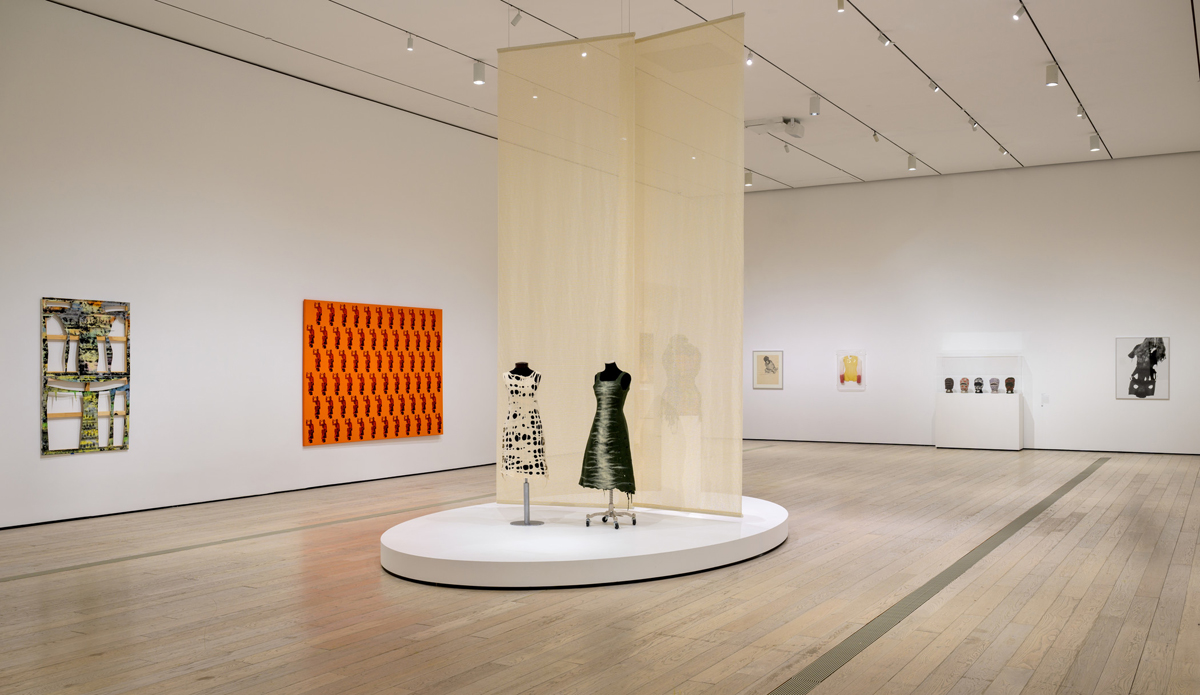
Woven Histories: Textiles and Modern Abstraction, installation view. © Museum Associates / LACMA.
The heir to Höch’s advertisements from 1924 and ’25, for instance, is Andrea Zittel’s ongoing series of billboard studies, while Liz Collins channels Delaunay’s exuberant color, nudging it toward fuchsia power. Elliott’s hairy, autumnal slump of woven cord from 1968 (cheekily titled Titanium White) might be the prototype for Ann Hamilton’s 2023 installation of twenty upcycled overcoats, each embellished with waxy wads of uncarded wool, fresh from the sheep. I smelled musk, and thought of loamy compost. Decorative fringe has never teemed with so much possibility: erotic, commanding, elegant, provisional.
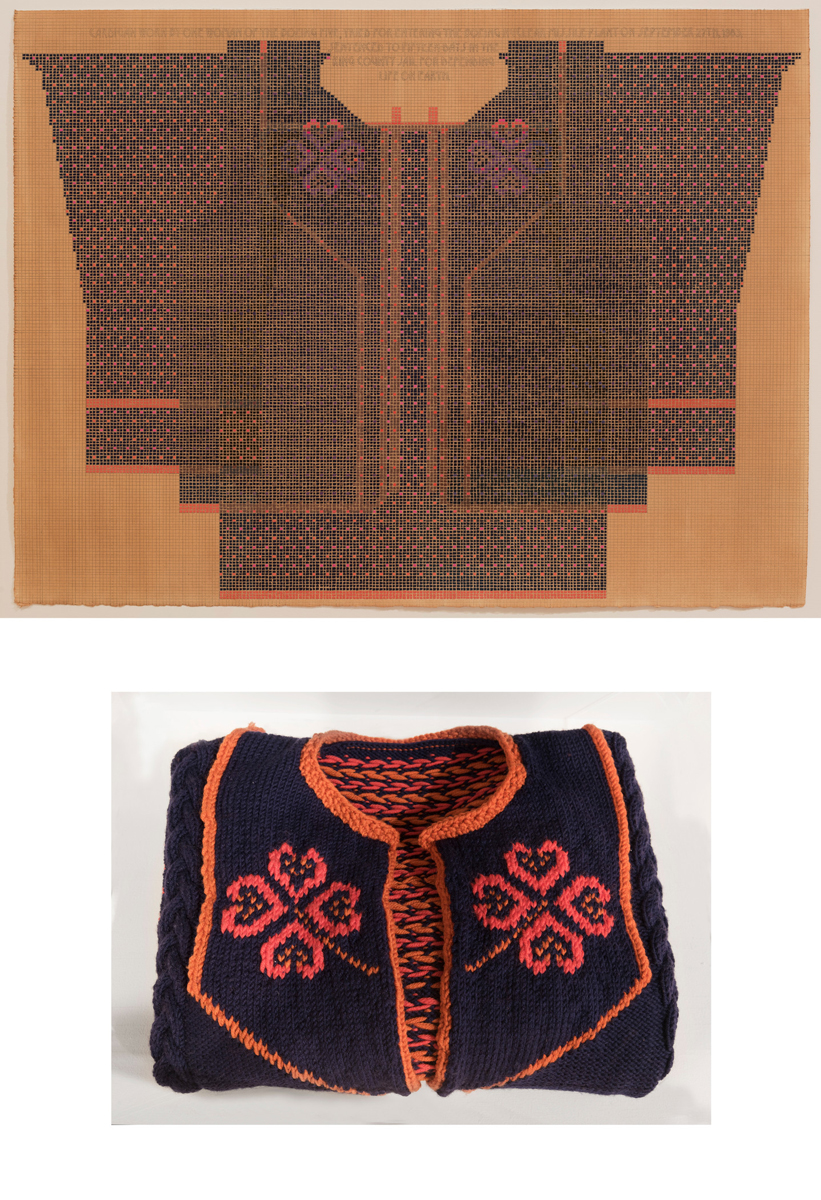
Ellen Lesperance, Cardigan Worn by One Woman of the Boeing Five, Tried for Entering the Boeing Nuclear Missile Plant on September 27th, 1983, Sentenced to Fifteen Days in the King County Jail for Defending Life on Earth, 2011. Photo: Brooklyn Museum. © Ellen Lesperance.
Holes abound. Anni Albers’s masterful With Verticals (1946) looks at first glance like a cloth riven with stab wounds, and her airy drawings of knots, I decided, are actually drawings of dollops and hollows. In the galleries devoted to contemporary practice, there are photograms of lace, fabric chewed by moths, and embroidery made to look like scabs. A potent triangle-shaped gap appears three times: in a bustling print by Ruth Asawa, ingeniously made with Black Mountain College’s laundry stamp; in another by Rosemarie Trockel, nested beside an image of women bathing; and as a tiny wire triangle sculpture by Arte Povera artist Marisa Merz, which reads as the sparest possible version of Courbet’s L’Origine du monde, holiest of holes.
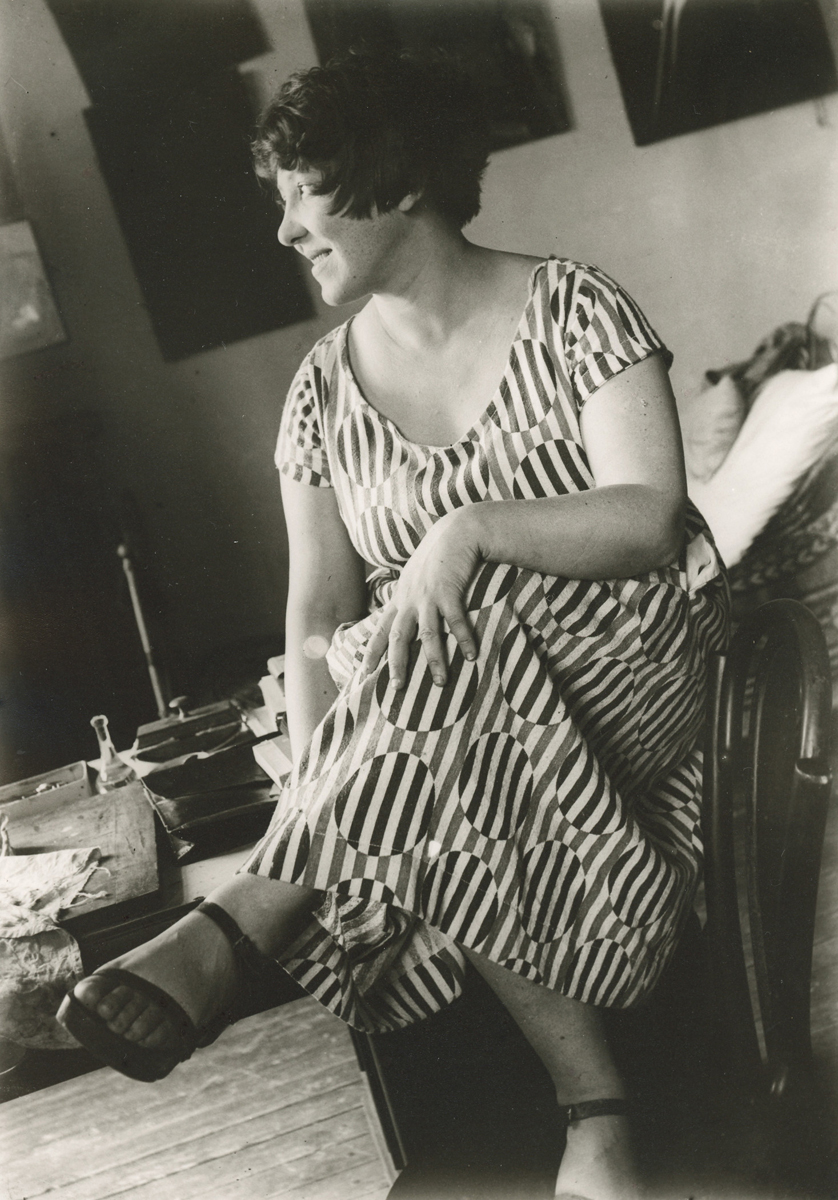
Alexander Rodchenko, Varvara Stepanova, 1924. © Estate of Alexander Rodchenko / Licensed by VAGA at Artists Rights Society.
The beginning of Woven Histories includes a 1924 photo of the Russian Constructivist Varvara Stepanova. Stepanova was a design polymath, and a nexus of interesting people and ideas; Cooke described her as an original “influencer.” In the snapshot, Stepanova’s at ease in a pageboy haircut, smiling over her shoulder, wearing a dress of her own design. It’s a photo to fall in love with, but a bit insulting, I grumbled, to include in lieu of any actual work by Stepanova.
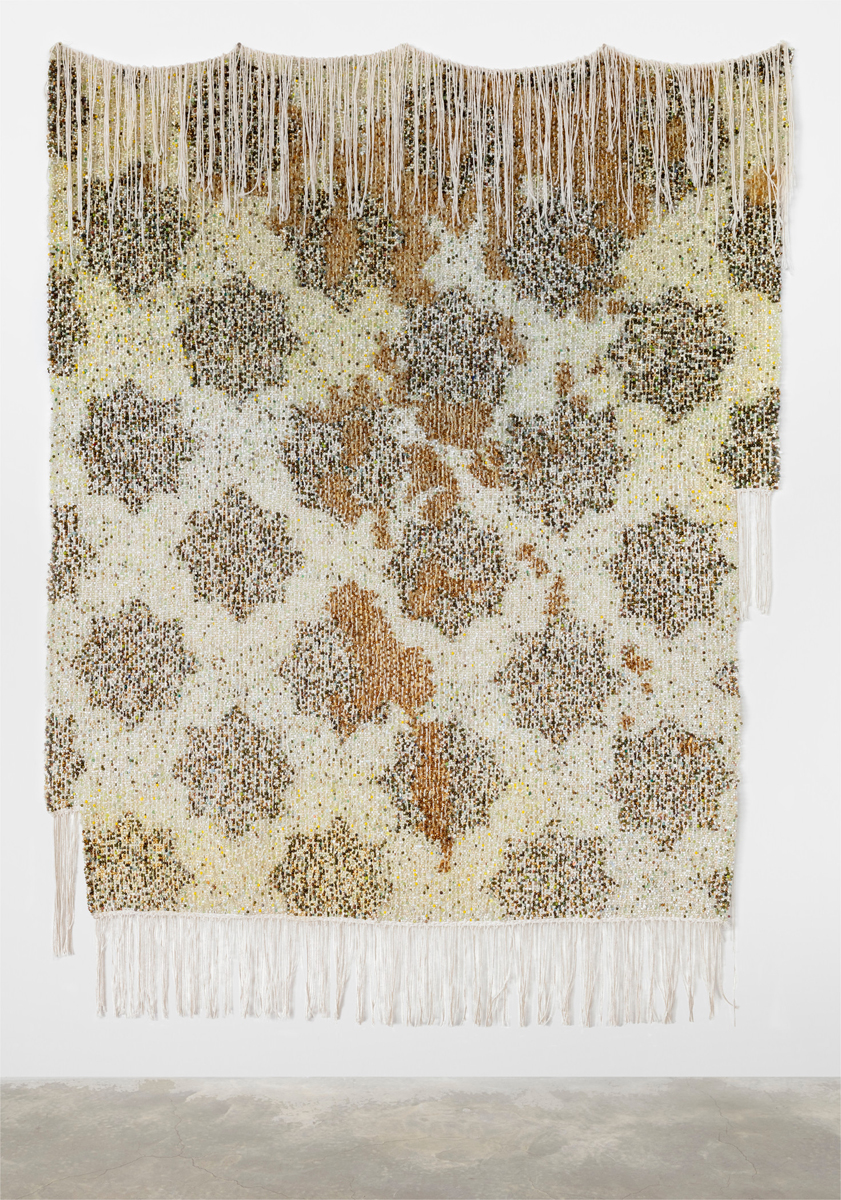
Igshaan Adams, Vroeglig by die Voordeur, 2020. Courtesy the artist and Casey Kaplan. Photo: Mario Todeschini. © Igshaan Adams.
A chorus of contemporary artists convinced me otherwise. Ellen Lesperance memorializes jailed environmental activists by recreating their hand-knitted sweaters, and a matriarch in Laura Huertas Millán’s film about a weaver’s co-op explains her disinterest in marriage as she clack, clack, clacks the shed stick. Diedrick Brackens’s weaving reads as a gambit for hard conversation, real conversation, and Igshaan Adams’s lux beadwork sumptuously reproduces a linoleum pattern ubiquitous to the Cape Town neighborhood of the artist’s childhood, as if to represent the dazzling feat of self-articulation between “was” and “is.” These are textiles for a feeling, thinking body, and Stepanova is there to smile encouragement.
Sasha Archibald’s essays have appeared in the White Review, the New Yorker, the Point, the Believer, and in books published by the Academy Museum of Motion Pictures, Walker Art Center, Whitechapel Gallery, and other institutions. She is an associate editor at Places Journal, a contributing editor at the Public Domain Review, and an editor-at-large at Cabinet.